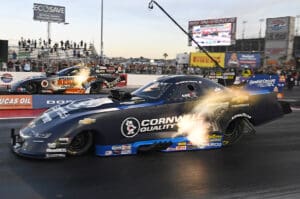Bill Bader Jr., whose family owns Summit Motorsports Park at Norwalk,
Ohio, adamantly insists that driver Randy Adler’s crash there  two
two
weekends ago during the Super Chevy event did not occur because of water on the track.
Nevertheless, the Baders are absorbing a six-figure repair bill for
half the length of the racing surface as this weekend’s Summit Racing
Equipment NHRA Nationals (with the Pro Stock K&N Horsepower
Challenge) approaches.
After more than five hours of discussions Friday with engineers, NHRA
Senior Vice President of Racing Operations Graham Light, and track-prep
consultant Wayne McMurtry, the Baders began ripping up and replacing
the asphalt racing surface from the eighth-mile to the finish line.
That, they said, will fix the drainage problems that the track has
experienced lately. However, a prepared statement from the family said
this problem is unrelated to the seepage trouble that popped up during
last year’s rain-soaked national event. Those, the statement said, were
"due to heavy rains in the days leading up to the event, which raised
the water table. Those problems were cured with the installation of
drainage in those areas."
Racer’s crash leads to questions headed into NHRA weekend …

Bill Bader Jr., whose family owns Summit Motorsports Park at Norwalk, Ohio, adamantly insists that driver Randy Adler’s crash there two

This shows the level of rain that officials at SREMP have faced in the past week.
weekends ago during the Super Chevy event did not occur because of water on the track.
Nevertheless, the Baders are absorbing a six-figure repair bill for half the length of the racing surface as this weekend’s Summit Racing Equipment NHRA Nationals (with the Pro Stock K&N Horsepower Challenge) approaches.
After more than five hours of discussions Friday with engineers, NHRA Senior Vice President of Racing Operations Graham Light, and track-prep consultant Wayne McMurtry, the Baders began ripping up and replacing the asphalt racing surface from the eighth-mile to the finish line.
That, they said, will fix the drainage problems that the track has experienced lately. However, a prepared statement from the family said this problem is unrelated to the seepage trouble that popped up during last year’s rain-soaked national event. Those, the statement said, were "due to heavy rains in the days leading up to the event, which raised the water table. Those problems were cured with the installation of drainage in those areas."
This latest damage, Bader said, was from "little bubbles of water percolating — not something we’ve seen before. Before it was tens of thousands of droplets of water."
The statement did acknowledge that "officials first detected a problem during last weekend’s Super Chevy event at the facility as water was seeping up through the track surface."

Crews worked on Saturday afternoon repaving the track from the eighth-mile to the shutdown.
With cooperative weather in the forecast, Bader Jr. indicated that the facility should be ready by this weekend’s 12th of 24 races on the Full Throttle Drag Racing Series schedule.
Said Bader, "We had three choices: A. Keep our fingers crossed and hope the track’s dry for the national event, B. Move the event, or C. Fix it. A and B weren’t options."
After a rainy Friday — "Murphy’s Law," Bader said — work crews started to mill off the top inch and a half of asphalt from where the concrete part of the racing surface ends to the finish line. That sand-packed asphalt mixture, laid down last May, "was retaining water and not allowing it to seep down into the earth," according to the statement.
"While the base is exposed, after the asphalt is taken off, we’ll install drainage down the center of the track and on the edges," Bader said.
He said Monday’s task would be to wash the track with Tide detergent to get rid of oils that new asphalt emits as it warms up. "Tide is the most aggressive cleaning agent," he said. It also is what the NHRA used several years ago during the national event at Brainerd, Minn., when "weepers" caused major delays in the action.
Workers plan to prep the track Tuesday, spraying it with rubber and traction compound, then dragging it.

NHRA’s Safety Safari battled weepers throughout last year’s event at SREMP.
"On Wednesday we hand the track over to the NHRA," Bader said. The sanctioning body, he said, has been extremely cooperative since it first heard about the problem.
Light said in a statement from the Baders, "We’ll be fine. This should give us a raceable surface. We applaud the Bader family and the staff at Summit Motorsports Park for their quick and proactive reaction to this situation. It’s obviously not a situation you would want to have, but without this work, we could have been in for quite a problem with any amount of rain."
Bader told Competition Plus that "it isn’t a matter of dollars and cents. It’s about delivering a safe racetrack."
That’s where the dispute with Adler, of Monee, Ill., came into play.
The two pairs of cars that ran immediately before him had no problem getting down the track, he said, but he claimed he hit a small patch of water.
"There was water seeping through the track," Adler said.
Referring to a spectator’s video of the incident that has been circulated through YouTube, Adler said, "You can see it (water) coming off the right rear tire. It looks like little puffs of smoke."
WATCH THE VIDEO
Adler said he was still on the throttle with his arm up, ready to pull the parachute. The car made a hard right-hand turn in front of Paul Athey in the opposite lane, flipped, and burst into flames as it skidded downtrack on its roof.
"He got into the wall," Adler said of Athey. "Otherwise, he would have driven through the center of my seat. He’s got enough experience to do that. He sacrificed his car. If not for his driving ability, we wouldn’t have walked away."
Furthermore, Adler said, the emergency response team "was very unprepared. That’s surprising, because this track isn’t a hole-in-the-wall. It’s a nice place."
He said the fire truck had trouble getting to scene, as it was parked behind a gate that no one seemed to be able to open quickly. He said once the truck arrived it had trouble getting water to move through the hose to put out the fire. Adler said a spectator, not emergency personnel, helped him from his burning car and that a volunteer fireman (the driver in the previous pairing, as it turned out) tried to help the officials with the hose but "was shooed away."
Adler and Bader agree that they — Athey included — had a conversation in the middle of the track about what had transpired, but Adler remembered it differently than Bader did. Adler said the track-prep vehicle had made its way to the scene of the initial impact and had cleaned up the water problem before the discussion.
"That is a lie. That is not true," Bader said. "I can only assume he was confused."
Athey, according to a post he made on an Internet message board, corroborated Adler’s account.
Wrote Athey, "I’m just glad I had just enough room to avoid hitting Randy when he did come in front of me. We both wish we hadn’t of made the run given the result, but what is done is done. As a racer, if the track crew tells me to start the car, I assume it is safe to go. Am I supposed to unbuckle myself, walk the track and then get back in?
"It is unfortunate that water on the track caused Randy to lose control," Athey wrote. "We were delayed for quite a while and the announcement was made over the PA that all classes would be run as eighth-mile because of water trouble on the big end. Interestingly, Bader Jr. was telling us as soon as we got out of our cars that the track was dry. Funny thing was that the tractor used to drag the track was already making rounds."
Adler said, "We had a whole big spiel in the middle of the track. It was a waste of time. We both know what happened. You don’t have to be a rocket scientist to know that. After it was cleaned up, he said, ‘See? There’s no water. This is what you were racing on.’ "
Bader’s take on it was that "it was not an adversarial conversation. We shook hands, and we resumed racing." Moreover, he said, "I am 100 percent there was no water on the racetrack."
He said that "perception is reality" and that "time becomes altered" in some circumstances and allowed that perhaps Adler was mistaken in the confusion.
He questioned why Adler hit the brakes suddenly, saying, "Our track is 4,000 feet long. If you’re racing in the eighth-mile, that leaves 3,400 feet of shutdown. Why didn’t he just coast? I didn’t ask him. He just wadded up a race car. I wasn’t going to grill him on the finer points of driving. I really can’t speculate. I wasn’t in the race car.
"I believe he believes what he’s saying," Bader said of Adler. "I do not want to question his integrity or question his driving ability. From what I understand, Mr. Adler is a fine race-car driver."
Adler said he also accepted his own measure of responsibility for the incident. "We chose to run. We could’ve said no — but we didn’t because this never happens."
He said he simply plans never to race again at Summit Motorsports Park. "It’s unfortunate that it took my car (wreck) to get the problem fixed," Adler said. "But if you’re willing to take a risk with somebody’s life, I don’t need to be at your race track."
Bader, on the other hand, said, "For him to suggest that, that’s insane. I started in this business with my dad when I was 10. And I’m not interested in compromising my integrity over a race accident. We never touched the racetrack, other than to clean up the debris from the accident. We never had to mop up, blow, or jet.
"We walked the track after every pair," Bader said, "and if water was there, we would’ve shut things off. There would’ve been no harm in doing that. If I have to refund spectators’ money, I just do. We always err on the side of the customers. You can’t lose if the customer wins. My grandmother always told me, ‘To thine own self be true.’ It’s not about money — it’s about being able to go home at night and look at yourself in the mirror, knowing you did the right thing."
Advertisement






































BOBBY BENNETT: THE REALITY NO ONE WANTED TO FACE AT POMONA